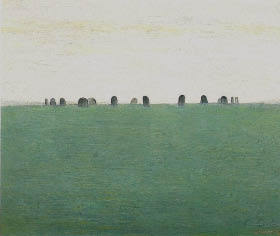Here at last is a book that takes L. S. Lowry’s art seriously and treats it with the scholarly attention it deserves.
Here at last is a book that takes L. S. Lowry’s art seriously and treats it with the scholarly attention it deserves. Tom Rosenthal has been a life-long admirer of Lowry’s work, spending his formative years in Greater Manchester and even interviewing the old curmudgeon for Radio 3 in the 1960s. One of his aims in this book is to dispel the various myths that have grown up around Lowry and his critically underestimated art. It has become fashionable in the art world to look down on Lowry as a naive painter who could only paint industrial landscapes full of ridiculous scampering matchstick people. Nothing could be further from the truth: actually Lowry was a deeply sophisticated artist with an enviable precision of drawing (if you look closely, his figures are subtly individuated, not generic) and with a far greater range of subject than is generally supposed. It’s high time his work was thoroughly reassessed.
One of the many snobbish prejudices against Lowry arises from his wide popularity amongst people who are not normally considered to understand painting; another is due to the huge sums his works regularly fetch in the auction rooms. Both are ludicrous and contemptible. It is a terrible indictment of the Tate Gallery that Lowry’s paintings are so rarely on view at the museum, and that there has been no major retrospective of his work in London since the Royal Academy’s exhibition of 1976, except for a touring show which came to the Barbican in 1988. The public deserves the chance to see a proper representation of Lowry’s work, sympathetically selected and challengingly presented. In the meantime, enthusiasts have either to make do with books of reproductions or journey to the Lowry heartlands of Salford where a major centre for his work, called simply The Lowry, was set up in 2000.
Rosenthal’s substantial book makes up somewhat for this shameful neglect. Although critics who have in the past written perceptively about Lowry include Kenneth Clark, Edwin Mullins, Julian Spalding and John Berger, recent writers have avoided this controversial figure. There was a tedious academic study published in 2000, and an idiosyncratic but useful celebration from Lowry’s one-time dealer Andras Kalman in 2003 (a book I co-authored), but apart from that the field was remarkably free. The anti-Lowry snobbery seemed even to extend to the big art publishers, despite the fact that a good book on Lowry was bound to sell well. A biography of the artist by the journalist Shelley Rohde was published in 1979 and revised and reissued in 2007, but until now there has been no significant monographic appreciation of the artist.
This large and handsome volume, with over 200 colour illustrations, is an indispensable guide to the art and mind of L. S. Lowry (1887–1976). Rosenthal identifies two basic themes in Lowry’s work: the industrial scenes and the grotesque people he loved to paint — the bearded lady, the cripples, a little girl with a vast mane of hair. To these I would add a third and equally important but certainly less familiar subsection: paintings of land and sea, more or less empty of people. These include some of his most haunting works: the great expanses of empty, rippling tides, the stone-walled fields of the North country, mountain lakes and such unlikely scenes as a stone circle in Cornwall (illustrated below) or an obelisk on a rock in mid-ocean. These pictures have been dubbed the ‘Lonely Lowrys’, and a selection of them may be seen at Crane Kalman Gallery, 178 Brompton Road, SW3 until 18 December.
Rosenthal points out that Lowry was not so much a recluse, as he’s often depicted, but a solitary who enjoyed the friendship of a wide circle while preferring to keep his friends in separate compartments. Thus few knew of the others, and Lowry gained a reputation for being a lonely man. Certainly he lived on his own after his mother died (Rosenthal is tough on the mother’s lack of support for her son’s art), but the selfishness and dedication required by the artist make living alone an honest solution. This book examines various strands of Lowry’s life, beginning aptly with Rosenthal’s own encounters with him and then tracing his relationships with collectors, artist contemporaries (such as David Carr and Shelia Fell), his attitude to women (complex), his technique and subject matter, and finally rejecting the theory that Lowry suffered from Asperger’s Syndrome.
Rosenthal has done his subject proud. This rich and stimulating book is a fitting tribute to an artist of considerable complexity, whose extraordinary work has been for too long sidelined in the annals of art history.






Comments